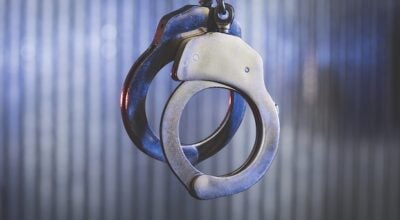Fighting back: Drug task force taking charge in Calcasieu Parish
Published 4:11 am Sunday, December 8, 2024

- Lt. Deputy Derek Goss, assistant director and division lieutenant of the Calcasieu Parish Sheriff’s Office Combined Anti-Drug Team (C.A.T.) Narcotics Task Force, speaks to members of the Kiwanis Club of Lake Charles at the Charleston Hotel on Tuesday. (Crystal Stevenson / American Press)
As little as two milligrams of fentanyl can be lethal. Last year, in Calcasieu Parish it led to nearly 100 deaths. This year, the Calcasieu Parish Sheriff’s Office Combined Anti-Drug Team (C.A.T.) Narcotics Task Force seized over 3,000 dosage units and two pounds of fentanyl powder, saving countless lives.
CPSO Lt. Deputy Derek Goss is the Task Force Assistant Director and Division Lieutenant. He spoke to the Kiwanis Club of Lake Charles Tuesday about task force is different from other agencies, the team’s three units and 2024 stats.
A detective on the team since 2012, the 39-year-old Lacassine native, who now calls Lake Charles home, worked his way up the ranks starting in patrol and airport security beginning in 2007.
“We’re a local-, state- and federal-supported drug unit,” he said, “made up of men and women from the Sheriff’s Office, Lake Charles Police Department, Iowa Police Department and Louisiana State Police.”
While the FBI, DEA and Homeland Security do not have a person serving with the C.A.T. Narcotics Task Force at this time as in the past, they do contribute resources, according to Goss. Manpower is a problem for those agencies just as it has been for the CPSO.
“Most of your drug task forces across the country are federally led and locally supported,” he said. “Ours is one of the longest-running locally led and federally supported programs that we are aware of — since 2005. And we plan to be around for quite some time.”
One team, three different anti-drug units
Officers who work for C.A.T., work for one of three units, street crimes, long-term and criminal patrol, Goss explained.
The street crimes unit focuses on preventing street-level narcotics, usually localized cases. Leads from the CPSO tip line, Crime Stoppers, emails and phone calls drive investigations.
Officers go out into the street to do their work. They surveil suspects, pull trash and knock doors to talk face-to-face. Sometimes informants are used.
The long-term unit’s focus is investigations that identify and investigate organized drug conspiracy enterprises with a hierarchy composed of five or more people.
“These are experienced detectives tasked with the job of attacking, dismantling and arresting every member of organized drug trafficking to ensure a successful prosecution,” Goss said.
The criminal patrol unit uses F-150s and four-legged investigators with a nose for sniffing out illegal items to patrol the Interstate 10 corridor.
“Two units work full time, 24/7 from the Jeff Davis Parish line to the Texas state line targeting individuals who are trafficking drugs, guns, people and money,” he said.
Goss expressed a keen admiration for their skill set, calling what they do “an art.” Criminal patrolmen and women zero in and analyze behavior during a brief amount of time to decide what might be making the drivers they stop appear to be nervous.
“It’s all about observing reactions. I’m a cop and I still get nervous when I see a cop, even if I am not speeding and I’m wearing my seat belt,” he said. “It’s human nature.”
However, these officers are so fine-tuned to certain criminal – and noncriminal – tell-tale signs. They can spot the difference between the reaction of a person who may be acting nervous because of a warrant out for them due to a traffic ticket they never paid, and the reaction of a person with 50 kilos of cocaine in the trunk. And, it’s a feat achieved inside a five- to 10-minute window, he said.
Criminal patrol officers have even spotted suspicious behavior in drivers doing 55 miles per hour down the interstate, he said.
“Sometimes we do get tips,” he said. “That’s part of it. We work with Houston. But I would say 95 percent or greater of the stops are not from tips.”
For the good guys, the ubiquitous watching of big brother might not always be a bad thing. License plate readers help with criminal patrol. However, the benefit of license plate readers has been realized mostly in the recovery of stolen vehicles within the parish.
The CPSO Task Force receives grant money based on a formula that assigns a dollar amount to every seized drug, gun and dollar. Every year the unit has to prove itself, going into details about how the patrol unit handles finding large amounts of cash.
The conclusion of Goss’s 2024 presentation to the Kiwanis Club of Lake Charles covered 2024 stats. The task force launched 414 narcotics investigations, stopped 42 undercover drug buys, issued 51 search warrants, 126 for felonies, knocked and talked at 160 doors and logged 7,500 surveillance hours.
Seventy-five pounds of cocaine were seized, one pound of crack, 454 pounds of meth, 283 pounds of marijuana and 21 pounds of synthetic marijuana.
Twenty-six guns were taken. Goss said when gun cases are completed and judged, guns that are stolen with serial numbers intact that have not been altered in a way that makes them illegal, can be returned to owners. Drugs are burned and/or disposed of in the manner specified for that particular substance.
About $284,000 was seized in currency, down from $1.5 million taken last year. Some of the other numbers were down as well, he said, and that’s due to manpower shortages.



